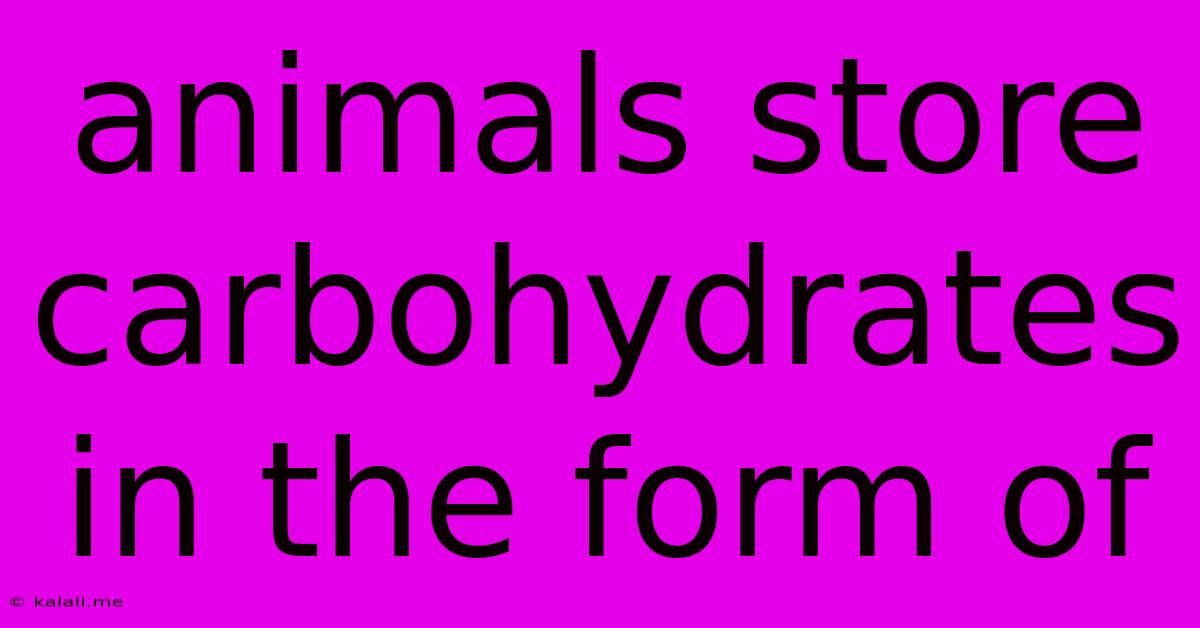Animals Store Carbohydrates In The Form Of
Kalali
Jun 14, 2025 · 3 min read

Table of Contents
Animals Store Carbohydrates in the Form of Glycogen: A Deep Dive
Meta Description: Discover how animals store carbohydrates, the crucial role of glycogen in energy metabolism, and its differences from plant starch storage. Learn about glycogen's structure, location, and its importance for survival.
Animals, unlike plants, don't store carbohydrates primarily as starch. Instead, they utilize a highly branched polysaccharide called glycogen. This article delves into the intricacies of glycogen, exploring its structure, storage location, and vital role in maintaining energy homeostasis. Understanding glycogen storage is key to comprehending animal metabolism and overall physiological function.
The Structure of Glycogen: A Branched Energy Reservoir
Glycogen's structure is crucial to its function. It's a polymer of glucose units, similar to starch, but with a key difference: its extensive branching. This branching creates a highly compact structure, maximizing the number of glucose units that can be stored in a small space. These branches also facilitate rapid glucose release when energy is needed. Think of it like a densely packed, easily accessible energy depot. The branches are formed by α-1,6-glycosidic bonds, while the linear chains are connected by α-1,4-glycosidic bonds. This unique arrangement allows for efficient enzymatic breakdown and subsequent glucose mobilization.
Where is Glycogen Stored? Prime Locations for Energy Reserves
Glycogen isn't distributed evenly throughout the body. The primary storage sites are:
- Liver: The liver acts as a crucial glycogen reservoir, providing glucose to maintain blood glucose levels during periods of fasting or intense activity. Hepatic glycogenolysis (the breakdown of glycogen in the liver) is vital for supplying glucose to the brain and other glucose-dependent tissues.
- Muscles: Skeletal muscles also store significant amounts of glycogen, primarily for their own energy needs during contraction. Muscle glycogen is directly utilized by muscle cells, contributing significantly to sustained physical activity. This intramuscular glycogen is not readily available to other tissues.
Smaller amounts of glycogen can also be found in other tissues, but the liver and muscles are the major contributors to overall body glycogen stores.
Glycogen Metabolism: The Dynamic Balance of Synthesis and Breakdown
The process of glycogen synthesis (glycogenesis) and breakdown (glycogenolysis) is tightly regulated to maintain blood glucose homeostasis. Hormones like insulin and glucagon play pivotal roles in controlling these processes. Insulin promotes glycogenesis, storing excess glucose as glycogen, while glucagon stimulates glycogenolysis, releasing glucose when blood sugar levels drop. This delicate balance is essential for survival, ensuring a continuous supply of energy to the body's cells. Understanding the intricate regulation of glycogen metabolism is key to understanding conditions like diabetes, where this regulation is impaired.
Glycogen vs. Starch: A Comparative Look at Carbohydrate Storage
While both glycogen and starch serve as carbohydrate storage molecules, they differ in their structure and function. Starch, found in plants, exists in two forms: amylose (linear) and amylopectin (branched). Amylopectin, the branched form, is less branched than glycogen, resulting in slower glucose release. This difference reflects the distinct metabolic needs of plants and animals. Plants can afford slower glucose release, while animals require a readily available energy source to meet their higher energy demands and maintain a stable blood glucose level.
Conclusion: The Importance of Glycogen in Animal Physiology
In conclusion, glycogen serves as the primary form of carbohydrate storage in animals, playing a critical role in energy metabolism and overall physiological function. Its highly branched structure facilitates rapid glucose mobilization, meeting the demands of various tissues and maintaining blood glucose homeostasis. Understanding the intricacies of glycogen storage, metabolism, and its regulatory mechanisms is crucial for comprehending animal physiology and the implications of metabolic disorders.
Latest Posts
Latest Posts
-
Least Common Multiple Of 14 And 20
Jun 14, 2025
-
Find Y If X 4 Y 4 16
Jun 14, 2025
-
Between Which Two Planets Is The Asteroid Belt Located
Jun 14, 2025
-
What Is Registered Mail Vs Certified Mail
Jun 14, 2025
-
What Is Prime Factorization Of 34
Jun 14, 2025
Related Post
Thank you for visiting our website which covers about Animals Store Carbohydrates In The Form Of . We hope the information provided has been useful to you. Feel free to contact us if you have any questions or need further assistance. See you next time and don't miss to bookmark.